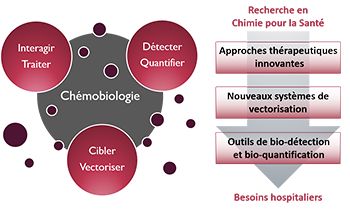- ⌂
-
Le DPM
Les Equipements
L'Environnement
Zoom sur... Le Bâtiment André Rassat
Nommé d'après une figure tutélaire de la chimie grenobloise, ce bâtiment est recouvert d’une double peau en feuille métallique qui apporte une protection thermique sur 3 côtés et crée une unité architecturale favorisant l'intégration parmi les arbres du site.
-
Thématiques
Le Thème
« Approches thérapeutiques innovantes »De nouvelles solutions thérapeutiques, de la cible biomacromolécu-laire émergente aux approches originales pour traiter les maladies
Le Thème
« Nouveaux systèmes de vectorisation »Combiner les propriétés d’inclusion de principes actifs, de franchisse-ment de barrières, d’adressage et de relar-gage en milieu vivant
Le Thème
« Outils de bio-détection et bio-quantification »Des dispositifs analytiques originaux pour la détection de cibles, de l’ion au micro-organisme en milieu complexe
Zoom sur... La Chémobiologie

-
Équipes
L'Équipe « COMET »
« COMET » développe la conception rationnelle, la synthèse et/ou l'extraction de composés à forte diversité/complexité comme nouveaux agents thérapeutiques et outils moléculaires pour la pénétration cellulaire ou la détection de biomolécules, actifs in vivo.L'Équipe « NOVA »
« NOVA » utilise des acides nucléiques fonctionnels comme éléments de reconnaissance pour des applications thérapeutiques ou diagnostiques, comme la sélection d'oligonucléotides, ou le développement de dispositifs d'analyses et de nanovecteurs.Les Services
-
Productions
Les Publications
La Vulgarisation
Les JSM
Zoom sur... La 12ème JSM (15 juin 2023)
Le DPM organise des journées scientifiques consacrées au médicament. L'objectif est de rassembler les spécialistes académiques et industriels autour d'une thématique. 2023 : Apports de la Chimie Click et de la Lumière en Chemobiologie
-
Partenariats
Les Formations
Les Consortiums
Les Financements
Zoom sur... L'environnement Grenoblois
Le DPM est un acteur central sur le bassin grenoblois en chimie, biologie et santé, lié au CHU Grenoble Alpes et à de nombreuses autres organisations : Pole de Recherche CBS, ICMG, Labex ARCANE, EUR CBH, Institut Carnot Polynat, Réseau GREEN.
Article
- Projet
- Ahcène BOUMENDJEL, Marine PEUCHMAUR, Basile PERES, Romain HAUDECOEUR,
- Titre
- Piperidinyl-Embeded Chalcones Possessing anti PI3Kδ Inhibitory Properties Exhibit Anti-atopic Properties in Preclinical Models
- Auteurs
- C. Dumontet, G.Beck, F. Gardebien, R. Haudecoeur, D. Mathé, E.-L. Matera, A. Tourette, E. Mattei, J. Esmenjaud, C. Boyere, A. Nurisso, M. Peuchmaur, B. Peres, G. Bouchaud, A. Magnan, G. Monneret and A. Boumendjeld
- Edition
- Eur. J. Med. Chem. 2018, In Press
- Année
- 2018
- Résumé
- Phosphatidylinositide 3-kinases (PI3Ks) are widely expressed enzymes involved in membrane signalization pathways. Attempts to administer inhibitors with broad activity against different isoforms have failed due to toxicity. Conversely the PI3Kδ isoform is much more selectively expressed, enabling therapeutic targeting of this isoform. Of particular interest PI3Kδ is expressed in human basophils and its inhibition has been shown to reduce anti-IgE induced basophil degranulation, suggesting that PI3Kδ inhibitors could be useful as anti-allergy drugs. Herein, we report for the first time the activity of compounds derived from chalcone scaffolds as inhibitors of normal human basophil degranulation and identified the most active compound with anti-PI3Kδ properties that was investigated in preclinical models. Compound 18, namely 1-[2-hydroxy-4,6-dimethoxy-3-(N-methylpiperidin-4-yl)phenyl]-3-(2,4,6-trimethoxyphenyl)-prop-2-en-1-one, was found to inhibit normal human basophil degranulation in a dose-dependent manner. In a murine model of ovalbumin-induced asthma, compound 18 was shown to reduce expiratory pressure while its impact on the inflammatory infiltrate in alveolar lavage and total lung was dependent on the route of administration. In a DNFB-induced model of atopic dermatitis compound 18 administered systemically proved to be as potent as topical betamethasone. These results support the anti-atopic and allergic properties of the title compound and warrant further clinical development.




 Annuaire
Annuaire Contact
Contact Plan d'accès
Plan d'accès ENG
ENG Login
Login



